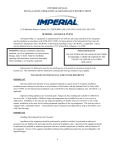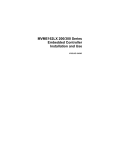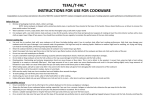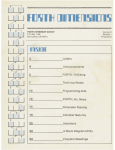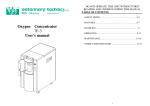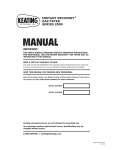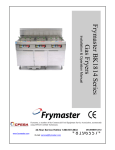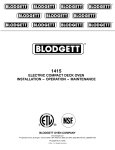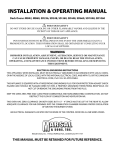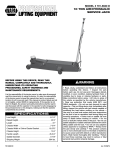Download OWNERS MANUAL INSTALLATION, OPERATION
Transcript
OWNERS MANUAL INSTALLATION, OPERATION, & MAINTENANCE INSTRUCTIONS ® 1128 Sherborn Street ▪ Corona, CA 92879-2089 ▪ (951) 281-1830 ▪ FAX (951) 281-1879 GAS FRYERS All Imperial Mfg. Co. equipment is manufactured for use with the type of gas specified on the rating plate and for installation in accordance with ANSI Z223.1/NFPA 54 (latest edition) of the National Fuel Gas Code, the National Gas Installation Code, CSA/B149.1 or the Propane Installation code, CSA/B149.1, as applicable. WARNING: Improper installation, adjustment, alteration, service or maintenance can cause property damage, injury or death. Read the installation, operating and maintenance instructions thoroughly before installing or servicing this equipment. FOR YOUR SAFETY DO NOT STORE OR USE GASOLINE OR OTHER FLAMMABLE VAPORS OR LIQUIDS IN THE VICINITY OF THIS OR ANY OTHER APPLIANCE. Instructions to be followed in case the user smells gas are to be posted in a prominent location in the kitchen area. This information shall be obtained by contacting the local gas company or gas supplier. PLEASE RETAIN THIS MANUAL FOR FUTURE REFERENCE IMPORTANT Installing, Operating and Service Personnel: Installation of the equipment should be performed by qualified, certified, licensed and/or authorized personnel who are familiar with and experienced in state/local installation codes. Operation of the equipment should be performed by qualified or authorized personnel who have read this manual and are familiar with the function of the equipment. Service of the equipment should be performed by qualified personnel who are knowledgeable with Imperial Ranges. SHIPPING DAMAGE CLAIM PROCEDURE The equipment is inspected & crated carefully by skilled personnel before leaving factory. The transportation company assumes full responsibility for safe delivery upon acceptance of this equipment. If shipment arrives damaged: 1. Visible loss or damage: Note on freight bill or express delivery and have signed by person making delivery. 2. File claim for damages immediately: Regardless of extent of damages. Concealed loss or damage: If damage is noticed after unpacking, notify transportation company immediately and file “Concealed Damage” claim with them. This should be done within fifteen (15) days from date delivery is made to you. Retain container for inspection 1 INSTALLATION INSTRUCTIONS: DO NOT install the fryer next to any open flame section of a broiler, range or any other appliance. The fryer should be placed in an area which is free from drafts and accessible for proper operation and servicing. The area around the fryer must be kept clear of combustible materials. CLEARANCE Sides Rear Floor COMBUSTIBLE 6” 6” 6” NON-COMBUSTIBLE 0” 0” 6” Installation on non-combustible floor only shall be with factory supplied legs or casters. Counter model (IFST-25) shall have 4” legs and is to be installed on a non-combustible counter or stand. It is also important not to obstruct the natural flow of combustion and ventilation air if the fryer is to operate properly. Provide adequate clearance around air openings into the combustion chamber. RATING PLATE: Before making any connections to the fryer, check the rating plate to be sure the fryer specifications concur with the type of gas to be supplied to the fryer. The rating plate is located on the inside of the door. Information on this plate includes model and serial numbers. When communicating with the factory about a unit or requesting special parts or information, this data is essential for proper identification. Other information on this plate is the BTU/hr input of the burners, operating gas pressure in inches WC, and whether the unit is orificed for natural or propane gas. Pilot lighting instructions are also located in the same area. GAS PIPING: The installation of the fryer must conform with local codes, or in the absence of local codes, with the National Fuel Code, ANSI Z223.1/NFPA 54, the National Gas Installation Code, CSA B149.1, as applicable. 1. 2. The fryer and its individual shut-off valve must be disconnected from the gas supply piping system during any pressure testing of that system at test pressures in excess of ½ Psig (3.45KPa). The fryer must be isolated from the gas supply piping system by closing its individual manual shut-off valve during any pressure testing of the gas supply piping system at test pressures equal to or less than 35 mbar (3.45 KPa). The fryer is provided with a ¾” NPT inlet. Your local gas supplier should consult the Local Fuel Gas Code for proper sizing and installation of gas piping. Generally, piping should be sized to provide a gas supply sufficient to meet the maximum demand of all gas appliances on a line without undue loss of pressure at the outlet to the equipment. The total BTU requirements of the equipment being served and the length of the piping from the meter to the appliances are major considerations in the proper design of the gas supply system. Sealants on pipe joints must be resistive to propane gas. Check for leaks at all connections with soap solution. Do not use flame to check for leaks. Imperial fryers are equipped with millivolt control system, it does not need an outside power source. VENTILATION: Proper ventilation is very important for the proper function of your fryer as well as to remove unwanted vapors and products of combustion. To keep your warranty in force, a proper ventilation system must be employed. 2 LEVELING: After setting in position, level the fryer front to back and left to right. If it is not leveled, the fryer may not function properly. LIGHTING INSTRUCTIONS: 1. 2. 3. 4. 5. 6. Set the thermostat and the gas cock dial on the combination gas valve to the “OFF” position. Wait for five minutes Turn gas cock dial on the combination gas valve to “PILOT” position. Depress the gas cock dial and apply a lighted match or taper to the pilot. Hold the gas cock dial depressed for about 30 seconds or until pilot stays lit before releasing. If the pilot does not stay lit, repeat steps 4 and 5. BURNERS/THERMOSTAT OPERATION: 1. 2. After the pilot is lit, turn the gas cock dial to “ON” position. Turn the thermostat dial to any temperature setting and observe the burners ignition. It should ignite within four seconds. CAUTION Burners shall not be “ON” when the vessel is empty. During testing, fill the vessel with liquid (oil or water) till above the heat transfer tubes. FLEXIBLE COUPLINGS, CONNECTORS AND CASTERS: If the unit is to be installed with flexible couplings and/or quick-disconnect fittings, the installer must use a heavy duty AGA design-certified commercial flexible connector of at least ¾” NPT (with suitable strain reliefs). The flexible connector must comply with the standard of Connectors for Movable Gas Appliances, ANSI Z21.69 and addendum Z21.69a (or latest edition) and a quick-disconnect device that complies with the standard for quickdisconnect devices for use with Gas Fuel should comply with ANSI Z21.41 and addendum Z721.41a (or latest edition). If disconnection of the restraint is necessary, make sure to reconnect restraint after the appliance has been returned to its originally installed position. Domestic gas or water connectors are not suitable! Restraining device may be attached to the back frame/panel of the unit. If the unit is to be installed with the optional casters, a flexible connector must be used and the same ANSI standards apply. Locking front casters are provided to limit the movement of the appliance without depending on the connector or associated piping. A suitable strain relief must be installed with the flexible connector. All connections must be sealed with a joint compound suitable for LP gas and all connections must be tested with a soapy water solution before lighting pilots. OPERATION INSTRUCTIONS WARNINGS Hot oil and hot surfaces can cause severe burns. Use caution when operating the fryer. Do not attempt to move the fryer filled with hot oil or shortening. Do not go near the area directly above the flue when fryer is in operation. Severe burns may be caused. Drain hot oil in metal containers, do not use plastic buckets or glass containers. 3 PREPARATION FOR USE: New units have a coating of oil on the interior of the vessel. Remove this coating with hot soapy water, washing soda, or any other grease dissolving liquid. Rinse thoroughly and drain until all residues are removed. Wipe dry. Clean the baskets, crumb screen and clean-out rod (if supplied). PILOT OPERATION: Check & make sure the pilot is lit. If not, refer to previous section for lighting the pilot. BEFORE TURNING THE BURNERS ON: 1. 2. 3. Fill the vessel with liquid shortening or oil up to the “oil level” marking. Do not attempt to melt block of solid shortening by setting it on top of the tubes. This will damage the vessel and scorch the fat. Either melt it first on another appliance or cut it into small pieces and pack tightly below, between and around the burner tubes, without leaving any air spaces around the tubes. Turn the burners “ON” for about 10 seconds and turn “OFF” for about a minute. Repeat this “ON-OFF” cycle until all the shortening is melted. If scorching (smoke) occurs, lower the “ON” time. Do not overfill the vessel.. MAIN BURNER OPERATION: After the vessel is filled with liquid shortening or oil, set the gas cock dial on the combination gas valve to the “ON” position. Turn thermostat to desired temperature setting. DAILY SHUT-DOWN: At the end of the day turn the gas cock dial on the combination gas valve and the thermostat to “OFF” position. Where applicable turn the power switch to “OFF” position. Filter the oil in all fryers. CLEANING: For continued performance efficiency and longevity of your fryer it is essential to carry out a good maintenance program. DAILY 1. 2. 3. Remove and wash thoroughly all “loose” parts (basket hanger, baskets, crumb screens, etc.) Wipe clean all exterior and interior accessible surfaces and parts. Filter the liquid oil/shortening at the end of the day, replace if necessary. If fryer is under heavy use, filter more often during the day. WEEKLY 1. 2. 3. 4. 5. 6. 7. 8. Shut down the fryer by turning off the gas cock dial and power supply, where applicable. Drain the fryer in a filter pan or steel container. Flush out sediments at the bottom of the vessel with liquid oil. Close the drain valve and fill the vessel with a mixture of boil-out solution and water. Relight the pilot and turn on the burners. When the solution starts to boil, turn off the thermostat and let the vessel soak to soften deposits and/or carbon spots. (Approximately 1 hour) Drain off solution, scrub the insides with brush and rinse thoroughly. Repeat the cleaning procedure, if necessary. Wipe dry with soft towels and refill with clean oil/shortening. 4 WARNING All water must be removed before adding oil or shortening. Not doing so can result in splattering of hot oil. STAINLESS STEEL: All stainless steel body parts should be wiped regularly with hot soapy water during the day and with a liquid cleaner designed for this material at the end of each day. DO NOT USE steel wool, abrasive cloths, cleansers or powders to clean stainless surface. If it is necessary to scrape stainless steel to remove encrusted materials, soak in hot water to loosen the material, then use a wood or nylon scraper. DO NOT USE a metal knife, spatula, or any other metal tool to scrape stainless steel. Scratches are almost impossible to remove. PREVENTIVE MAINTENANCE: Periodically have a qualified service personnel check and adjust all the control components. CHECKING AND CALIBRATING THERMOSTAT: CHECKING: 1. 2. 3. 4. Fill the vessel with liquid oil/shortening up to the “oil level” marking. Turn the thermostat and set @ 325°F. Set a thermometer in the oil and let the fryer cycle few times before reading the thermometer. If the temperature differential between the thermostat and the thermometer is more that 5°F, recalibrate the thermostat. CALIBRATING: 1. 2. Pull the thermostat knob out. Use a screwdriver to turn the trim screw inside the thermostat stem. Turn counterclockwise to increase and clockwise to decrease the temperature. (Do not turn the stem while turning the screw!). Re-install the knob and check to see if the thermostat setting and the thermometer reading are the same. REMOVAL AND REPLACEMENT OF PARTS WARNING Shut-off gas supply before servicing this equipment. The following to be performed by qualified service personnel. BURNERS: 1. 2. 3. Loosen the bolts at the top of the burner Hold the venturi portion, slide up and push back to remove Reverse procedure to replace GAS VALVE: Disconnect wires from the valve and unscrew the pipe fittings. PILOT: 1. 2. Disconnect tubing and thermopile from the pilot by unscrewing the nut. Remove screws holding the pilot to the mounting bracket. 5 THERMOSTAT/HI-LIMIT: 1. 2. Drain vessel. Unscrew and remove the bulb holding down the bracket. Unscrew the nut at the vessel bottom. Pull the bulb out from underneath. Pull the thermostat knob out. Unscrew the thermostat/hi-limit from the mounting bracket. Reverse the procedure to install. FOR SERVICE OR ORDERING PARTS: Have the following information ready before contacting for service or ordering. 1. 2. 3. Model number and serial number of the fryer Type of gas used (natural or propane) and altitude if over 2000 feet Part name and the corresponding part number. Contact the factory service at (951)281-1830 or FAX (951)281-1879 or any factory authorized service agency and/or parts distributors 6 TROUBLE SHOOTING PROBLEM Pilot will not light Pilot will not stay lit Main burners will not ignite Fryer does not heat up Oil/shortening scorches and breaks down Temperature cannot be controlled Fryer shut-off, cannot relight pilot PROBABLE CAUSE A. No gas REMEDY A. Turn main gas valve "ON" B. Gas cock dial not set at "Pilot" position and depressed. B. Set gas cock dial on combination gas valve to "Pilot". Depress and hold while lighting A. Gas cock dial not depressed and held long enough. B. Defective thermopile A. Depress and hold for at least 30 seconds. B. Replace. C. Pilot flame not properly adjusted C. Adjust pilot flame with pilot adjustment screw on the combination valve. A. Pilot not lit. B. Thermopile not properly installed in the pilot. A. Light the pilot. B. Push in and tighten. Pilot flame should engulf the thermopile. C. Gas cock dial not set at "ON" position. C. Turn and set gas cock dial to "ON" position. D. Thermostat not set at any temperature. E. Defective gas valve. F. Defective hi-limit switch. D. Set thermostat to desired temperature. E. Replace. F. Replace. A. Insufficient gas. B. Line clogged. A. Check gas pressure. B. Remove and clean gas line. C. Overloading the fryer. C. Cook smaller loads. Need larger fryer. A. Operating temperature too high. B. Thermostat out of calibration C. Oil/shortening overused. A. Set at proper temperature B. Re-calibrate C. Replace with new D. Oil/shortening not filtered frequently. D. Under heavy usage, filter frequently during the day A. Thermostat bulb out of proper position B. Thermostat out of calibration. C. Defective thermostat D. Defective gas valve A. Relocate and secure at the proper position B. Re-calibrate C. Replace D. Replace A. B. C. D. A. Note: Cannot relight the pilot until temperature of oil drops to 325°F. Call service, if uncertain. B. Replace C. Recalibrate D. Replace Hi-limit cut off Defective thermostat Thermostat out of calibration. Hi-limit switch defective 7 8








